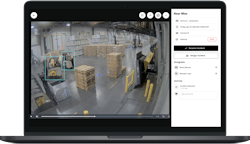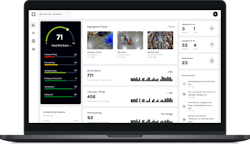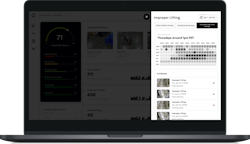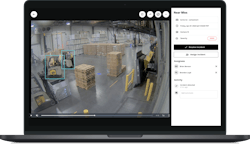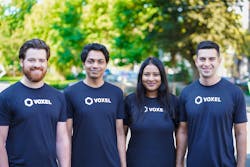How Voxel Combines Video Feeds and AI to Assess and Mitigate Workplace Safety
A big differentiator for Voxel’s computer vision technology is that it combines AI tools with existing security cameras to avoid slips, trips and falls in industrial workplaces, according to Alex Senemar, CEO, Voxel.
A high-level description of the startup’s technology is this: Video feeds from a facility’s existing security camera systems are connected to an edge computing appliance, which sends information to Voxel Cloud for analysis. The footage is analyzed and flagged for unsafe events and risky behaviors. This footage is then shared with the client for review and anomalies can be addressed at the facility.
“We look at the leading indicators of risk and leading indicators of safety and injuries that take place in the workplace, and we try to identify them via the existing security cameras, using the artificial intelligence and computer vision models we develop,” explained Senemar, who previously co-founded Sherbit, an AI-powered remote health monitoring system for hospitals. (The company was acquired in 2018.)
Where AI shines in the environment, health and safety (EHS) space is in its predictive capabilities that provide leading indicators for mitigating risk and creating safer workplaces. From data analysis to automation, artificial intelligence tools can be used to proactively manage risk in various EHS applications.
San Francisco-based Voxel’s platform is geared toward analyzing environmental hazards and ergonomic risks. Analyzing repetitive movements and motions that could lead to injury over time, such as poor lifting and overreaching, are examples. Another is logging events around powered vehicle safety, such as forklifts speeding in a warehouse that result in collisions.
“Our algorithms are consistently picking those up and giving insight into where the speed is occurring, and how people are turning and the types of driving patterns that take place in those environments,” explained Senemar.”
Voxel’s AI can capture protective equipment, such as hard hats and safety gloves and boots. “These are things that could cause injury if you don’t wear the right type of equipment in the workplace,” Senemar said.
The leading cause of work-related injuries and illnesses involving days away from work in 2020 is exposure to harmful substances, followed by overexertion and bodily reaction, then slips, trips and falls, according to the National Safety Council (NSC). These three causes account for more than 75% of all nonfatal injuries and illnesses involving days away from work.
READ MORE: Modeling a New Frontier with Emergent Technologies
If Voxel aims to make a lasting impression on industrial operations by creating real-time visibility and offering analytics that can protect workers, Fortune 500 firms are taking note. Voxel already counts Clorox, PPG Industries, and Office Depot among users of its platform. Strategic partners report up to an 80% reduction in workplace injuries, along with improvements in operational efficiency, said the company’s press release.
In a recent strategic funding round, the company secured $12 million from Rite-Hite, bringing total funding to $30 million since it launched in 2020. Existing investors include Eclipse Ventures and World Innovation Lab.
“This strategic investment was led by Rite-Hite,” Senemar said. “They are one of the largest players in the industrial safety space, looking specifically at loading dock doors and other types of fencing and guarding that is using different industrial environments. And the partnership with us is to grow with them as a company and also help support more customers through that partnership. The other part that we’re looking at is more of a global expansion. We’re looking at trying to tap into other markets outside of the North American market, and scaling the business.”
What follows below is a sampling of questions based on an interview with Senemar. (Content has been edited for clarity.)
Rehana Begg: Can you elaborate on how Voxel integrates the computer vision technology into existing cameras? What sets you apart? What makes it state of the art?
Alex Senemar: We’ve essentially built very generalized AI models that we can deploy right off the bat. And they’ve seen hundreds of thousands of hours of video at this point. We’ve been able to train on different versions and iterations of each one of these events. And those connect directly to the camera. We get up and running within 48 hours at customer sites.
It’s matured quite a bit. And if you actually look at our team, most of them came from the self-driving car space, where a lot of the key learnings have happened in computer vision and AI from that world. We are looking at environments constantly, and how those models can generalize and effectively scale across 200-300 warehouses at a time. When you look at these large companies, they have quite a large footprint of industrial areas where injuries can take place.
We’ve developed everything internally and we do have a really strong AI research team within Voxel itself that has developed it. It’s really a mix of the IP that we developed, but also the data that we’ve been able to see and train our models on to grow and understand these environments in a more mature way.
READ MORE: An Injection Molder Embraces Emergent Technology with Robotics as a Service
RB: You mentioned identifying potential risk such as near-miss vehicle collisions, blocked exits, improper ergonomics or spills. These are very different scenarios. Talk about the data collection and the analytics for these seemingly unique situations. For example, do you customize the application for various facilities or various customers?
AS: We do customize based on the use cases and the safety rules and behaviors that site is looking for. We have generalized models that look for key things around a forklift or the speed at which it’s taking place, or how fast it’s moving compared to a person, and how close those two objects are getting together. So, we’re doing a lot of modeling as well within the two-dimensional camera image. And then we are able to extract that information via AI models. We have rules and parameters the customer can adjust accordingly.
I can give you some examples: At some customer sites, they want people to slow down at the end of an aisle, whereas in another, the customer site wants someone to come to a complete stop. Our system needs to be able to effectively adjust, based on the behaviors and the patterns of safety that are being put in place at that workplace and adjust to their environment. So that’s a big part of the value proposition of Voxel.
RB: It all seems a very proactive in the way the company can approach it. How do plants use the data, for example, to reduce workers compensation and general liability costs and then also improve operations? I guess I’m having trouble understanding how they analyze the data and make those determinations.
AS: Capturing a lot of data is just one part of that life cycle. It’s how do you integrate into the culture of the environments that you’re in, and also help them be effective with that information, and training employees, and getting in front of potential injuries that could take place in that worksite? When we do actually capture this data? There are a few things. One is that we’re providing the leading indicators of risk and then safety.
Typically, the way it works today is, you have an injury or some kind of near-miss event that occurred. You take a record of that and then try to update your safety policies. Now, the way that we are fundamentally changing that with Voxel is that we provide [tangible data] on unsafe behaviors in that lower level of the safety pyramid, such as what are those key things that are happening that are driving those injuries for you, and give you 24/7 visibility into those things.
READ MORE: Full Automation: The Path to Lights-Out Production
When you run a program like Voxel, essentially, what you’re looking at is, how do you coach those behaviors out? And how do you engage—whether it’s in your safety meeting, or if there’s some kind of activity that’s taking place—how do you engage the employees and have the right discussions?
We don’t provide any facial recognition as part of our platform. So, we don’t actually know who the individual is. That is actively violating a rule, or some event might have taken place. It’s more a coaching platform that [provides concrete data] and taking that information and having effective discussions. It’s not just discussing poor behavior, but also rewarding good behavior.
That’s the program we built around the Voxel platform, where we actually support the customers, to bring that into the workplace and help behavior change.
RB: Anonymity is an important aspect here. Alex, I binge-read anything related to AI and existential threats. But setting aside over-hyped, hypothetical harms, ethics will still play a huge part in developing responsible data-driven solutions. What I’m really interested in is how individual, valid and useful applications can be leveraged for negative impact and unintended consequences—for example, cyberattacks, or misinformation, or malicious use. Tell me more about the privacy and security safeguards and how your development and design team build that into their thinking.
AS: I think there are two parts to this. One is the security and one is the privacy.
On the security side: That’s a place we made a significant amount of investment as a company because we work with leading companies in the country—a lot of Fortune 500 companies. And our systems are fully SOC 2* compliant. We do a lot of processing on site to avoid sending a lot of video across internet where there could be potential vulnerabilities for a customer.
And then, the other thing we do from a privacy standpoint is that we don’t actually detect the individuals on site. This is video they already have. We’re just telling them key analytics and moments that they should be reviewing and discussing with their teams to help reduce those events that it could take place from an injury standpoint.
*Editor’s note: “SOC” or system and organizational controls, refers to a cybersecurity compliance framework as outlined by the American Institute of Certified Public Accountants (AICPA). To be compliant means a service organization has completed third-party audits that demonstrate it has certain controls and safeguards in place. SOC 2 provides controls for various Trust Services Criteria, including security, confidentiality, processing integrity and privacy.
About the Author

Rehana Begg
Editor-in-Chief, Machine Design
As Machine Design’s content lead, Rehana Begg is tasked with elevating the voice of the design and multi-disciplinary engineer in the face of digital transformation and engineering innovation. Begg has more than 24 years of editorial experience and has spent the past decade in the trenches of industrial manufacturing, focusing on new technologies, manufacturing innovation and business. Her B2B career has taken her from corporate boardrooms to plant floors and underground mining stopes, covering everything from automation & IIoT, robotics, mechanical design and additive manufacturing to plant operations, maintenance, reliability and continuous improvement. Begg holds an MBA, a Master of Journalism degree, and a BA (Hons.) in Political Science. She is committed to lifelong learning and feeds her passion for innovation in publishing, transparent science and clear communication by attending relevant conferences and seminars/workshops.
Follow Rehana Begg via the following social media handles:
X: @rehanabegg
LinkedIn: @rehanabegg and @MachineDesign
